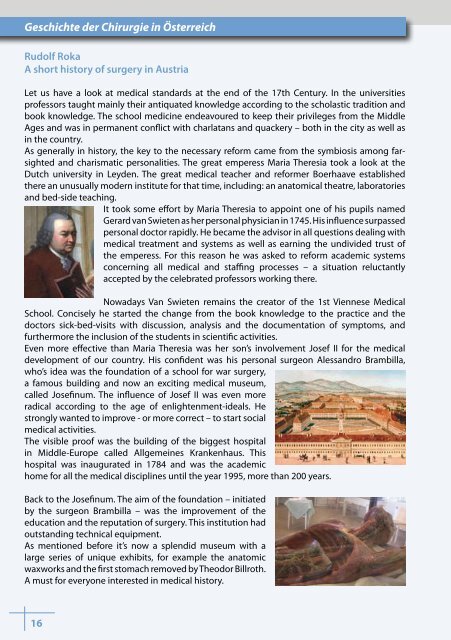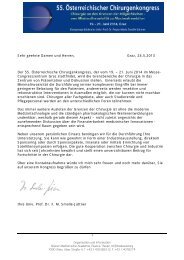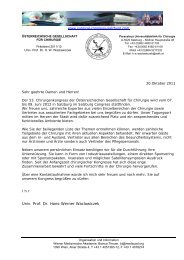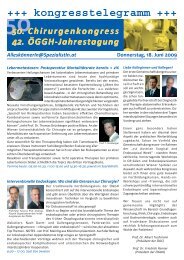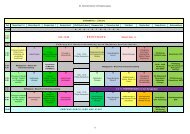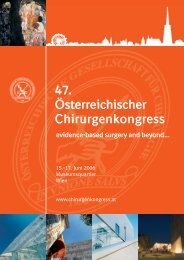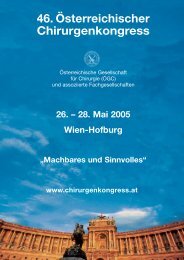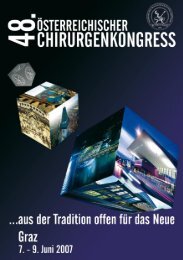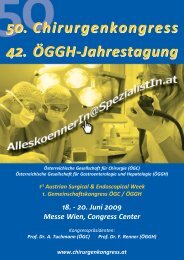3w - 54. Österreichischer Chirurgenkongress
3w - 54. Österreichischer Chirurgenkongress
3w - 54. Österreichischer Chirurgenkongress
Erfolgreiche ePaper selbst erstellen
Machen Sie aus Ihren PDF Publikationen ein blätterbares Flipbook mit unserer einzigartigen Google optimierten e-Paper Software.
Geschichte der Chirurgie in Österreich<br />
Rudolf Roka<br />
A short history of surgery in Austria<br />
Let us have a look at medical standards at the end of the 17th Century. In the universities<br />
professors taught mainly their antiquated knowledge according to the scholastic tradition and<br />
book knowledge. The school medicine endeavoured to keep their privileges from the Middle<br />
Ages and was in permanent conflict with charlatans and quackery – both in the city as well as<br />
in the country.<br />
As generally in history, the key to the necessary reform came from the symbiosis among farsighted<br />
and charismatic personalities. The great emperess Maria Theresia took a look at the<br />
Dutch university in Leyden. The great medical teacher and reformer Boerhaave established<br />
there an unusually modern institute for that time, including: an anatomical theatre, laboratories<br />
and bed-side teaching.<br />
It took some effort by Maria Theresia to appoint one of his pupils named<br />
Gerard van Swieten as her personal physician in 1745. His influence surpassed<br />
personal doctor rapidly. He became the advisor in all questions dealing with<br />
medical treatment and systems as well as earning the undivided trust of<br />
the emperess. For this reason he was asked to reform academic systems<br />
concerning all medical and staffing processes – a situation reluctantly<br />
accepted by the celebrated professors working there.<br />
Nowadays Van Swieten remains the creator of the 1st Viennese Medical<br />
School. Concisely he started the change from the book knowledge to the practice and the<br />
doctors sick-bed-visits with discussion, analysis and the documentation of symptoms, and<br />
furthermore the inclusion of the students in scientific activities.<br />
Even more effective than Maria Theresia was her son’s involvement Josef II for the medical<br />
development of our country. His confident was his personal surgeon Alessandro Brambilla,<br />
who’s idea was the foundation of a school for war surgery,<br />
a famous building and now an exciting medical museum,<br />
called Josefinum. The influence of Josef II was even more<br />
radical according to the age of enlightenment-ideals. He<br />
strongly wanted to improve - or more correct – to start social<br />
medical activities.<br />
The visible proof was the building of the biggest hospital<br />
in Middle-Europe called Allgemeines Krankenhaus. This<br />
hospital was inaugurated in 1784 and was the academic<br />
home for all the medical disciplines until the year 1995, more than 200 years.<br />
Back to the Josefinum. The aim of the foundation – initiated<br />
by the surgeon Brambilla – was the improvement of the<br />
education and the reputation of surgery. This institution had<br />
outstanding technical equipment.<br />
As mentioned before it’s now a splendid museum with a<br />
large series of unique exhibits, for example the anatomic<br />
waxworks and the first stomach removed by Theodor Billroth.<br />
A must for everyone interested in medical history.<br />
16


